Analyzing Natural Monopoly: Characteristics, Regulation, and Control
VerifiedAdded on 2020/03/02
|8
|2114
|62
Essay
AI Summary
This economics assignment provides a comprehensive analysis of natural monopolies. It begins by defining natural monopolies and their characteristics, such as high fixed costs and unique resources. The paper uses examples and diagrams to illustrate concepts like marginal revenue, marginal cost, and average cost in a monopoly setting. It explores the reasons for the rise of monopolies, including barriers to entry, and differentiates between regulated and unregulated natural monopolies. The assignment further delves into the consequences of unregulated monopolies, such as overcharging and operational wastefulness, and discusses various methods of government regulation, including price control, subsidies, and antitrust policies. The analysis also considers the impact of monopolies on consumers and producers, comparing them to competitive markets. The paper concludes by emphasizing the importance of government and social presence in curbing monopolies, highlighting the role of legislation, consumer associations, and nationalization in controlling unfair practices. The assignment also touches upon historical examples of regulation and the ongoing debate regarding government intervention in large businesses.
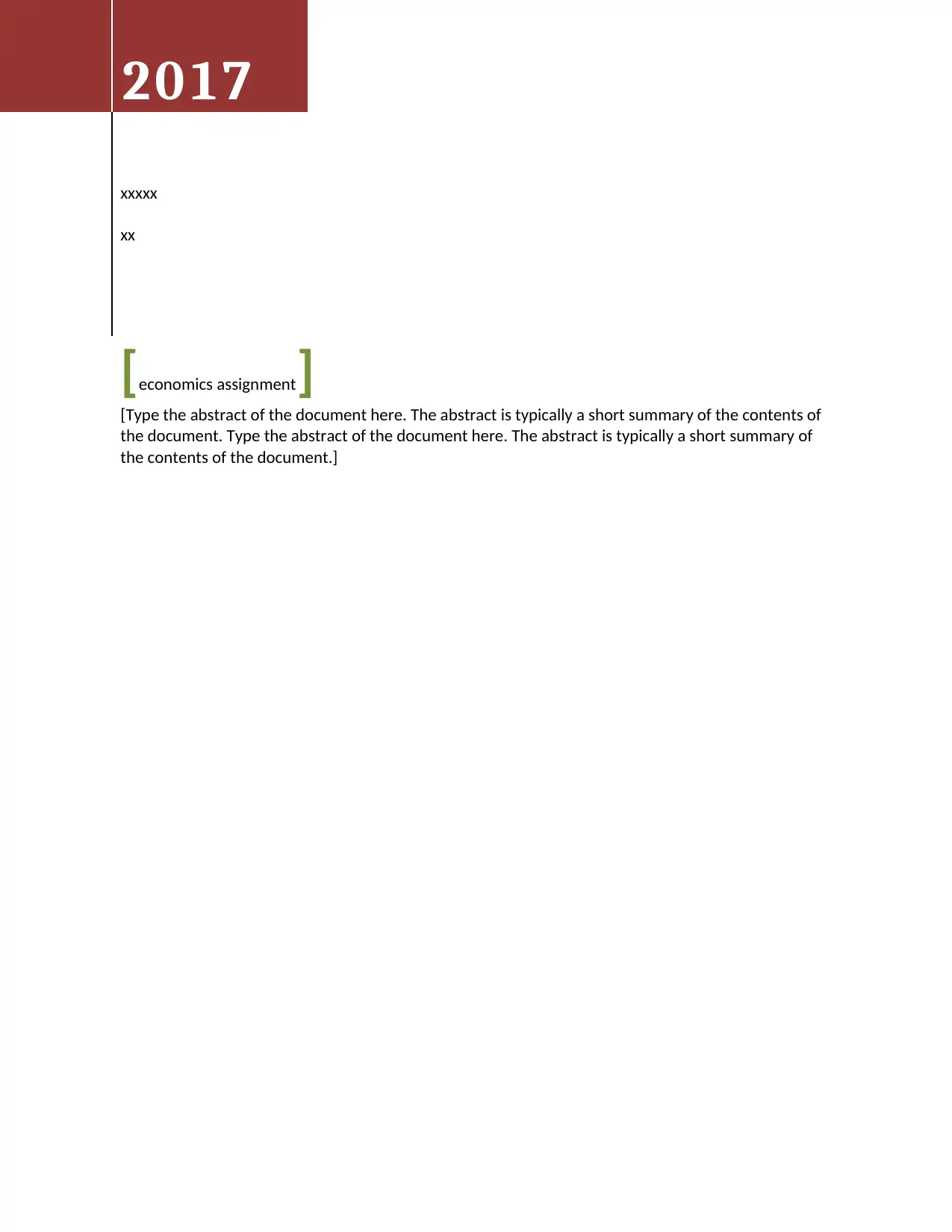
[economics assignment]
[Type the abstract of the document here. The abstract is typically a short summary of the contents of
the document. Type the abstract of the document here. The abstract is typically a short summary of
the contents of the document.]
2017
xxxxx
xx
[Type the abstract of the document here. The abstract is typically a short summary of the contents of
the document. Type the abstract of the document here. The abstract is typically a short summary of
the contents of the document.]
2017
xxxxx
xx
Paraphrase This Document
Need a fresh take? Get an instant paraphrase of this document with our AI Paraphraser
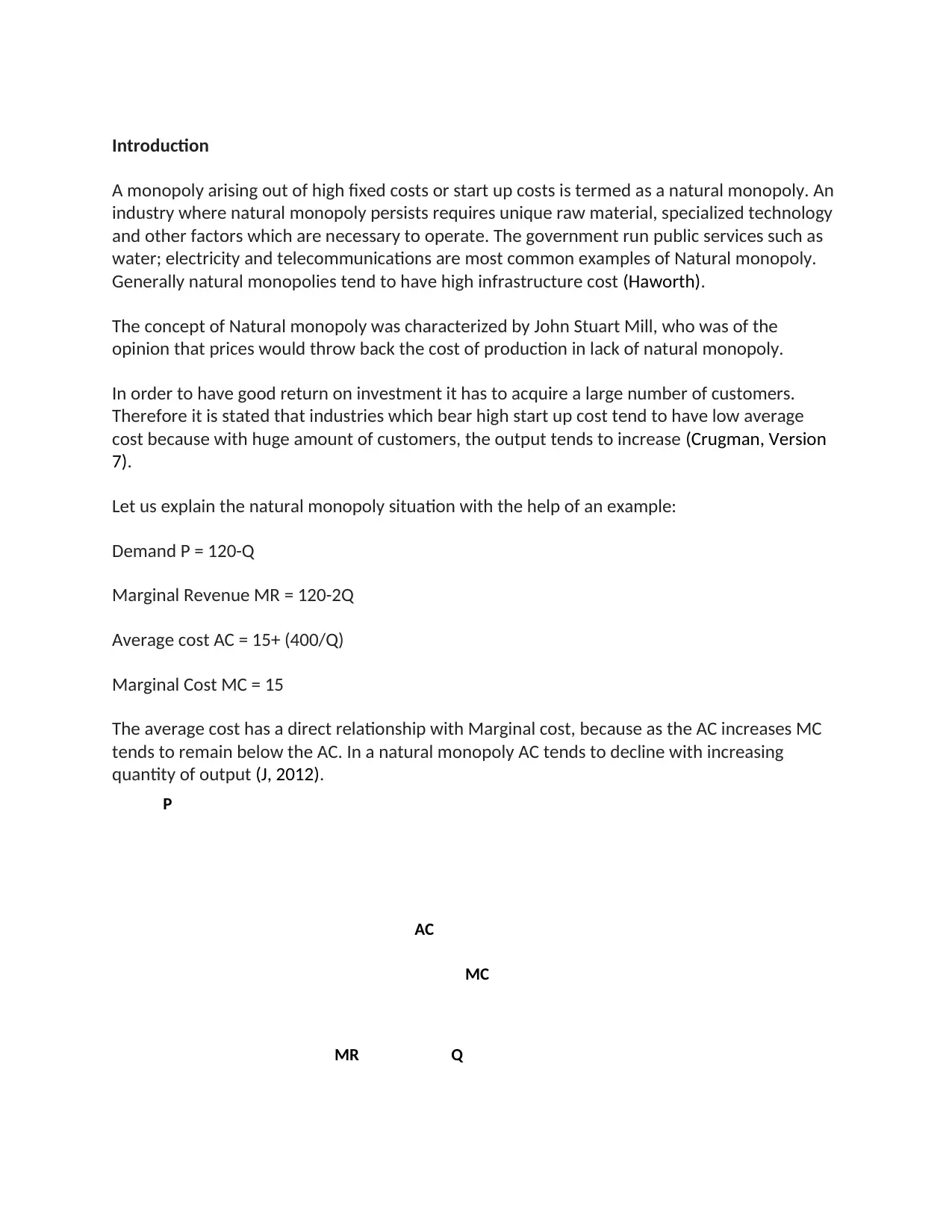
Introduction
A monopoly arising out of high fixed costs or start up costs is termed as a natural monopoly. An
industry where natural monopoly persists requires unique raw material, specialized technology
and other factors which are necessary to operate. The government run public services such as
water; electricity and telecommunications are most common examples of Natural monopoly.
Generally natural monopolies tend to have high infrastructure cost (Haworth).
The concept of Natural monopoly was characterized by John Stuart Mill, who was of the
opinion that prices would throw back the cost of production in lack of natural monopoly.
In order to have good return on investment it has to acquire a large number of customers.
Therefore it is stated that industries which bear high start up cost tend to have low average
cost because with huge amount of customers, the output tends to increase (Crugman, Version
7).
Let us explain the natural monopoly situation with the help of an example:
Demand P = 120-Q
Marginal Revenue MR = 120-2Q
Average cost AC = 15+ (400/Q)
Marginal Cost MC = 15
The average cost has a direct relationship with Marginal cost, because as the AC increases MC
tends to remain below the AC. In a natural monopoly AC tends to decline with increasing
quantity of output (J, 2012).
MR Q
MC
AC
P
A monopoly arising out of high fixed costs or start up costs is termed as a natural monopoly. An
industry where natural monopoly persists requires unique raw material, specialized technology
and other factors which are necessary to operate. The government run public services such as
water; electricity and telecommunications are most common examples of Natural monopoly.
Generally natural monopolies tend to have high infrastructure cost (Haworth).
The concept of Natural monopoly was characterized by John Stuart Mill, who was of the
opinion that prices would throw back the cost of production in lack of natural monopoly.
In order to have good return on investment it has to acquire a large number of customers.
Therefore it is stated that industries which bear high start up cost tend to have low average
cost because with huge amount of customers, the output tends to increase (Crugman, Version
7).
Let us explain the natural monopoly situation with the help of an example:
Demand P = 120-Q
Marginal Revenue MR = 120-2Q
Average cost AC = 15+ (400/Q)
Marginal Cost MC = 15
The average cost has a direct relationship with Marginal cost, because as the AC increases MC
tends to remain below the AC. In a natural monopoly AC tends to decline with increasing
quantity of output (J, 2012).
MR Q
MC
AC
P
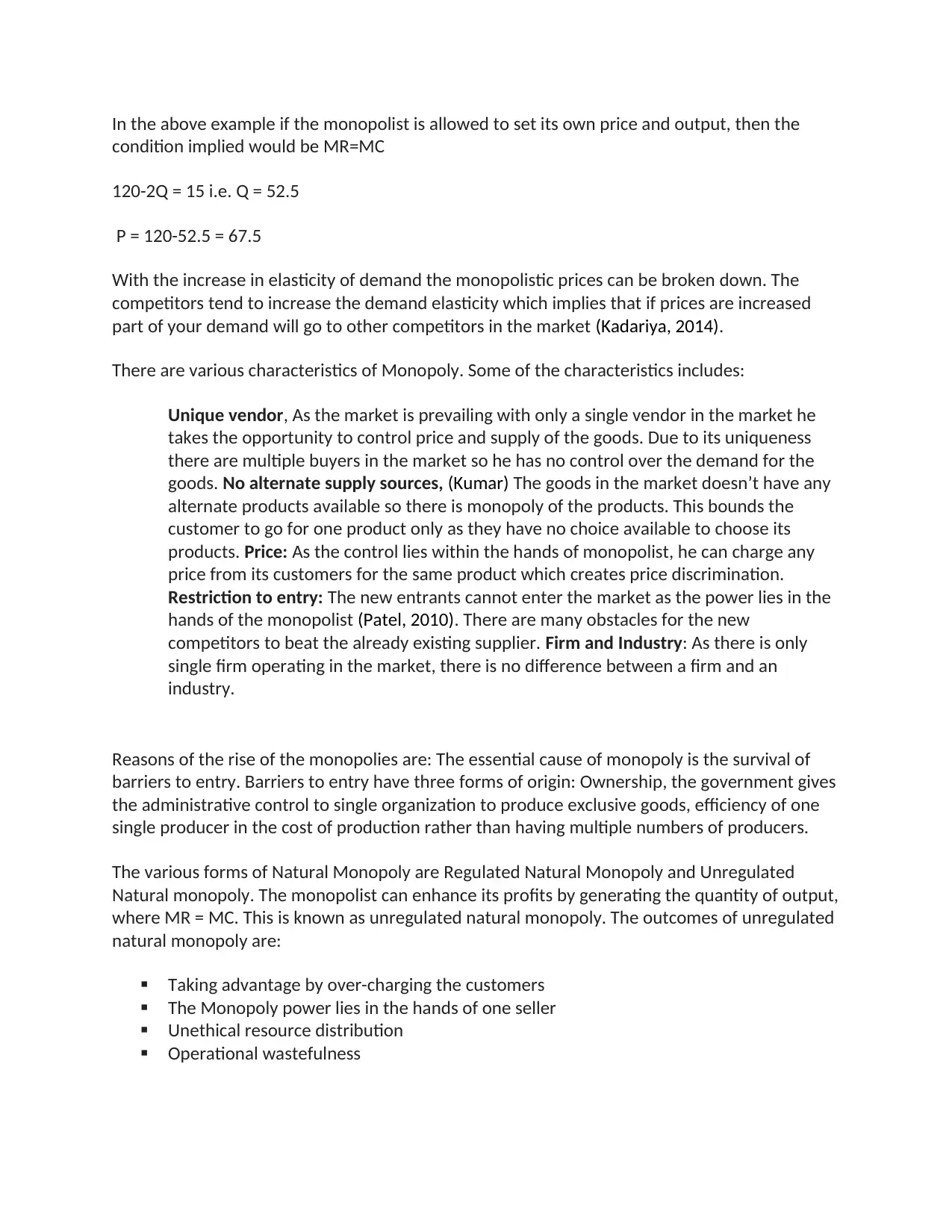
In the above example if the monopolist is allowed to set its own price and output, then the
condition implied would be MR=MC
120-2Q = 15 i.e. Q = 52.5
P = 120-52.5 = 67.5
With the increase in elasticity of demand the monopolistic prices can be broken down. The
competitors tend to increase the demand elasticity which implies that if prices are increased
part of your demand will go to other competitors in the market (Kadariya, 2014).
There are various characteristics of Monopoly. Some of the characteristics includes:
Unique vendor, As the market is prevailing with only a single vendor in the market he
takes the opportunity to control price and supply of the goods. Due to its uniqueness
there are multiple buyers in the market so he has no control over the demand for the
goods. No alternate supply sources, (Kumar) The goods in the market doesn’t have any
alternate products available so there is monopoly of the products. This bounds the
customer to go for one product only as they have no choice available to choose its
products. Price: As the control lies within the hands of monopolist, he can charge any
price from its customers for the same product which creates price discrimination.
Restriction to entry: The new entrants cannot enter the market as the power lies in the
hands of the monopolist (Patel, 2010). There are many obstacles for the new
competitors to beat the already existing supplier. Firm and Industry: As there is only
single firm operating in the market, there is no difference between a firm and an
industry.
Reasons of the rise of the monopolies are: The essential cause of monopoly is the survival of
barriers to entry. Barriers to entry have three forms of origin: Ownership, the government gives
the administrative control to single organization to produce exclusive goods, efficiency of one
single producer in the cost of production rather than having multiple numbers of producers.
The various forms of Natural Monopoly are Regulated Natural Monopoly and Unregulated
Natural monopoly. The monopolist can enhance its profits by generating the quantity of output,
where MR = MC. This is known as unregulated natural monopoly. The outcomes of unregulated
natural monopoly are:
Taking advantage by over-charging the customers
The Monopoly power lies in the hands of one seller
Unethical resource distribution
Operational wastefulness
condition implied would be MR=MC
120-2Q = 15 i.e. Q = 52.5
P = 120-52.5 = 67.5
With the increase in elasticity of demand the monopolistic prices can be broken down. The
competitors tend to increase the demand elasticity which implies that if prices are increased
part of your demand will go to other competitors in the market (Kadariya, 2014).
There are various characteristics of Monopoly. Some of the characteristics includes:
Unique vendor, As the market is prevailing with only a single vendor in the market he
takes the opportunity to control price and supply of the goods. Due to its uniqueness
there are multiple buyers in the market so he has no control over the demand for the
goods. No alternate supply sources, (Kumar) The goods in the market doesn’t have any
alternate products available so there is monopoly of the products. This bounds the
customer to go for one product only as they have no choice available to choose its
products. Price: As the control lies within the hands of monopolist, he can charge any
price from its customers for the same product which creates price discrimination.
Restriction to entry: The new entrants cannot enter the market as the power lies in the
hands of the monopolist (Patel, 2010). There are many obstacles for the new
competitors to beat the already existing supplier. Firm and Industry: As there is only
single firm operating in the market, there is no difference between a firm and an
industry.
Reasons of the rise of the monopolies are: The essential cause of monopoly is the survival of
barriers to entry. Barriers to entry have three forms of origin: Ownership, the government gives
the administrative control to single organization to produce exclusive goods, efficiency of one
single producer in the cost of production rather than having multiple numbers of producers.
The various forms of Natural Monopoly are Regulated Natural Monopoly and Unregulated
Natural monopoly. The monopolist can enhance its profits by generating the quantity of output,
where MR = MC. This is known as unregulated natural monopoly. The outcomes of unregulated
natural monopoly are:
Taking advantage by over-charging the customers
The Monopoly power lies in the hands of one seller
Unethical resource distribution
Operational wastefulness
⊘ This is a preview!⊘
Do you want full access?
Subscribe today to unlock all pages.

Trusted by 1+ million students worldwide
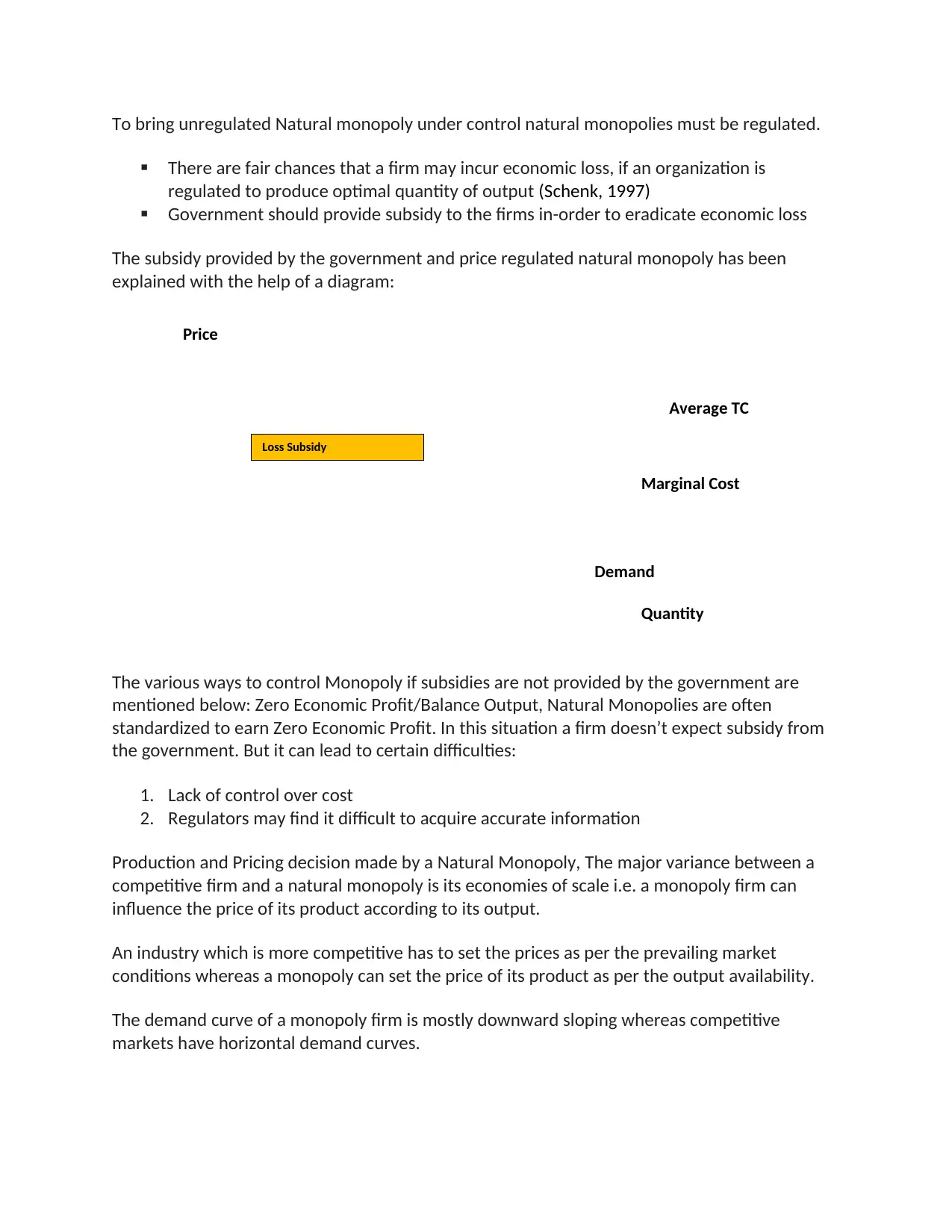
Compromise Outcome
Ideal Outcome
To bring unregulated Natural monopoly under control natural monopolies must be regulated.
There are fair chances that a firm may incur economic loss, if an organization is
regulated to produce optimal quantity of output (Schenk, 1997)
Government should provide subsidy to the firms in-order to eradicate economic loss
The subsidy provided by the government and price regulated natural monopoly has been
explained with the help of a diagram:
The various ways to control Monopoly if subsidies are not provided by the government are
mentioned below: Zero Economic Profit/Balance Output, Natural Monopolies are often
standardized to earn Zero Economic Profit. In this situation a firm doesn’t expect subsidy from
the government. But it can lead to certain difficulties:
1. Lack of control over cost
2. Regulators may find it difficult to acquire accurate information
Production and Pricing decision made by a Natural Monopoly, The major variance between a
competitive firm and a natural monopoly is its economies of scale i.e. a monopoly firm can
influence the price of its product according to its output.
An industry which is more competitive has to set the prices as per the prevailing market
conditions whereas a monopoly can set the price of its product as per the output availability.
The demand curve of a monopoly firm is mostly downward sloping whereas competitive
markets have horizontal demand curves.
Quantity
Demand
Marginal Cost
Loss Subsidy
Average TC
Price
Ideal Outcome
To bring unregulated Natural monopoly under control natural monopolies must be regulated.
There are fair chances that a firm may incur economic loss, if an organization is
regulated to produce optimal quantity of output (Schenk, 1997)
Government should provide subsidy to the firms in-order to eradicate economic loss
The subsidy provided by the government and price regulated natural monopoly has been
explained with the help of a diagram:
The various ways to control Monopoly if subsidies are not provided by the government are
mentioned below: Zero Economic Profit/Balance Output, Natural Monopolies are often
standardized to earn Zero Economic Profit. In this situation a firm doesn’t expect subsidy from
the government. But it can lead to certain difficulties:
1. Lack of control over cost
2. Regulators may find it difficult to acquire accurate information
Production and Pricing decision made by a Natural Monopoly, The major variance between a
competitive firm and a natural monopoly is its economies of scale i.e. a monopoly firm can
influence the price of its product according to its output.
An industry which is more competitive has to set the prices as per the prevailing market
conditions whereas a monopoly can set the price of its product as per the output availability.
The demand curve of a monopoly firm is mostly downward sloping whereas competitive
markets have horizontal demand curves.
Quantity
Demand
Marginal Cost
Loss Subsidy
Average TC
Price
Paraphrase This Document
Need a fresh take? Get an instant paraphrase of this document with our AI Paraphraser
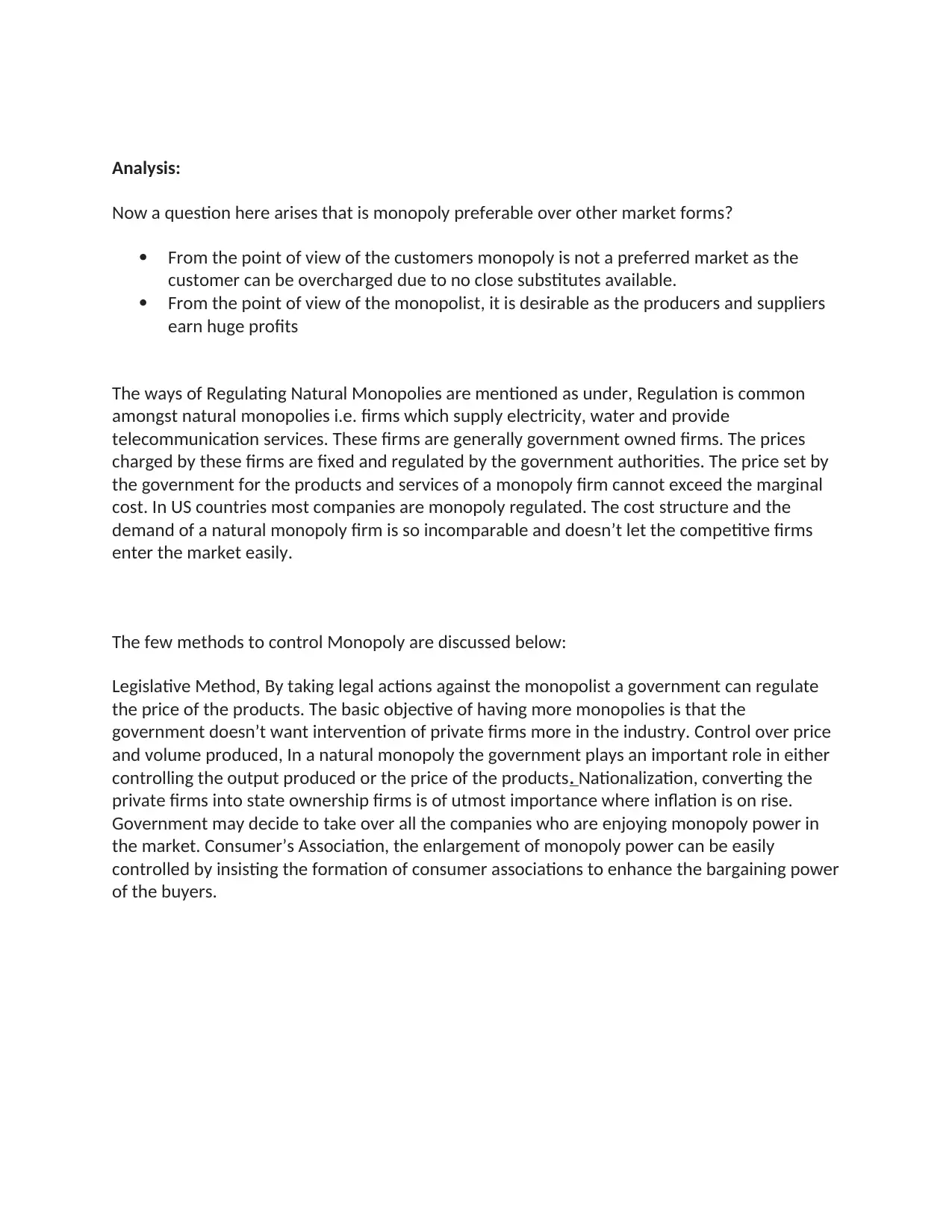
Analysis:
Now a question here arises that is monopoly preferable over other market forms?
From the point of view of the customers monopoly is not a preferred market as the
customer can be overcharged due to no close substitutes available.
From the point of view of the monopolist, it is desirable as the producers and suppliers
earn huge profits
The ways of Regulating Natural Monopolies are mentioned as under, Regulation is common
amongst natural monopolies i.e. firms which supply electricity, water and provide
telecommunication services. These firms are generally government owned firms. The prices
charged by these firms are fixed and regulated by the government authorities. The price set by
the government for the products and services of a monopoly firm cannot exceed the marginal
cost. In US countries most companies are monopoly regulated. The cost structure and the
demand of a natural monopoly firm is so incomparable and doesn’t let the competitive firms
enter the market easily.
The few methods to control Monopoly are discussed below:
Legislative Method, By taking legal actions against the monopolist a government can regulate
the price of the products. The basic objective of having more monopolies is that the
government doesn’t want intervention of private firms more in the industry. Control over price
and volume produced, In a natural monopoly the government plays an important role in either
controlling the output produced or the price of the products. Nationalization, converting the
private firms into state ownership firms is of utmost importance where inflation is on rise.
Government may decide to take over all the companies who are enjoying monopoly power in
the market. Consumer’s Association, the enlargement of monopoly power can be easily
controlled by insisting the formation of consumer associations to enhance the bargaining power
of the buyers.
Now a question here arises that is monopoly preferable over other market forms?
From the point of view of the customers monopoly is not a preferred market as the
customer can be overcharged due to no close substitutes available.
From the point of view of the monopolist, it is desirable as the producers and suppliers
earn huge profits
The ways of Regulating Natural Monopolies are mentioned as under, Regulation is common
amongst natural monopolies i.e. firms which supply electricity, water and provide
telecommunication services. These firms are generally government owned firms. The prices
charged by these firms are fixed and regulated by the government authorities. The price set by
the government for the products and services of a monopoly firm cannot exceed the marginal
cost. In US countries most companies are monopoly regulated. The cost structure and the
demand of a natural monopoly firm is so incomparable and doesn’t let the competitive firms
enter the market easily.
The few methods to control Monopoly are discussed below:
Legislative Method, By taking legal actions against the monopolist a government can regulate
the price of the products. The basic objective of having more monopolies is that the
government doesn’t want intervention of private firms more in the industry. Control over price
and volume produced, In a natural monopoly the government plays an important role in either
controlling the output produced or the price of the products. Nationalization, converting the
private firms into state ownership firms is of utmost importance where inflation is on rise.
Government may decide to take over all the companies who are enjoying monopoly power in
the market. Consumer’s Association, the enlargement of monopoly power can be easily
controlled by insisting the formation of consumer associations to enhance the bargaining power
of the buyers.
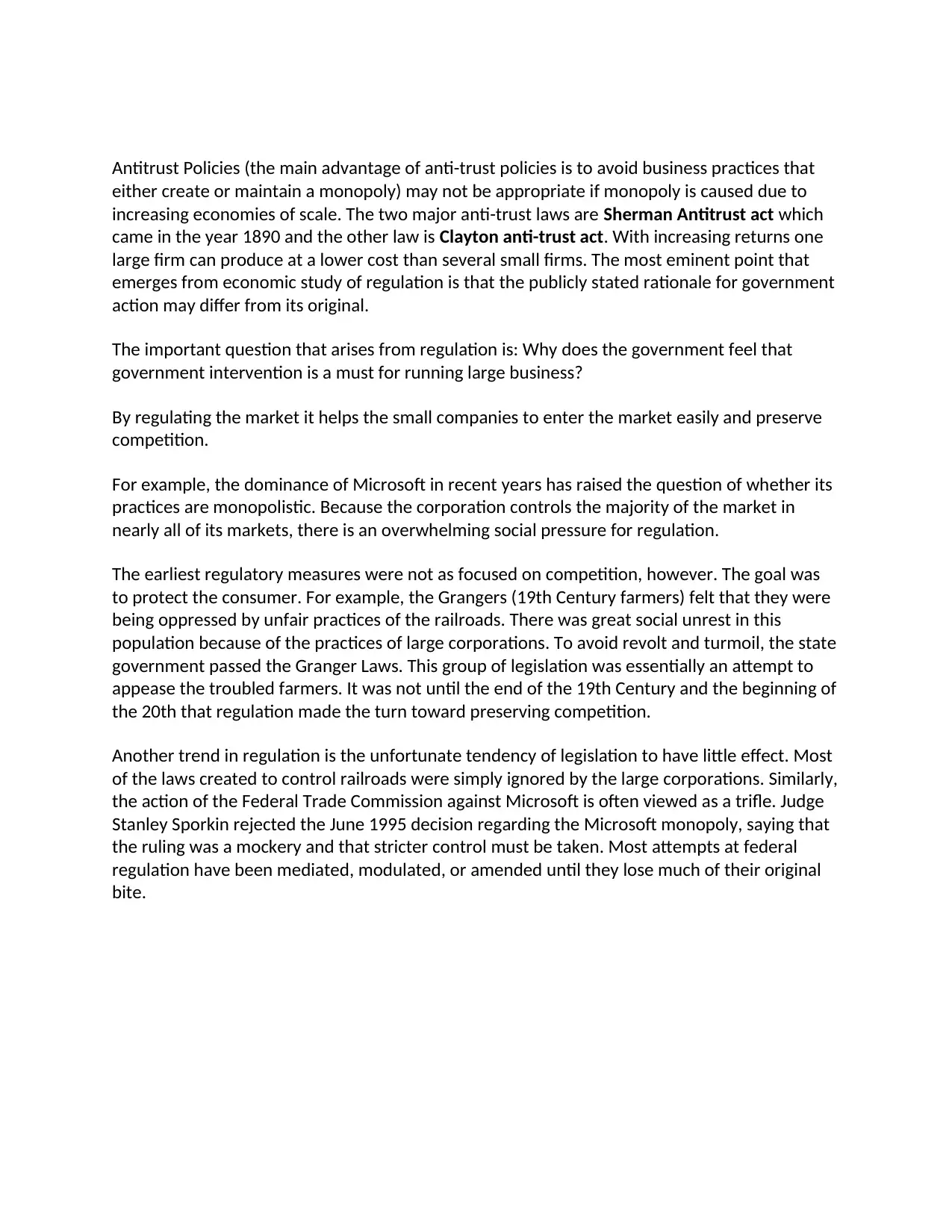
Antitrust Policies (the main advantage of anti-trust policies is to avoid business practices that
either create or maintain a monopoly) may not be appropriate if monopoly is caused due to
increasing economies of scale. The two major anti-trust laws are Sherman Antitrust act which
came in the year 1890 and the other law is Clayton anti-trust act. With increasing returns one
large firm can produce at a lower cost than several small firms. The most eminent point that
emerges from economic study of regulation is that the publicly stated rationale for government
action may differ from its original.
The important question that arises from regulation is: Why does the government feel that
government intervention is a must for running large business?
By regulating the market it helps the small companies to enter the market easily and preserve
competition.
For example, the dominance of Microsoft in recent years has raised the question of whether its
practices are monopolistic. Because the corporation controls the majority of the market in
nearly all of its markets, there is an overwhelming social pressure for regulation.
The earliest regulatory measures were not as focused on competition, however. The goal was
to protect the consumer. For example, the Grangers (19th Century farmers) felt that they were
being oppressed by unfair practices of the railroads. There was great social unrest in this
population because of the practices of large corporations. To avoid revolt and turmoil, the state
government passed the Granger Laws. This group of legislation was essentially an attempt to
appease the troubled farmers. It was not until the end of the 19th Century and the beginning of
the 20th that regulation made the turn toward preserving competition.
Another trend in regulation is the unfortunate tendency of legislation to have little effect. Most
of the laws created to control railroads were simply ignored by the large corporations. Similarly,
the action of the Federal Trade Commission against Microsoft is often viewed as a trifle. Judge
Stanley Sporkin rejected the June 1995 decision regarding the Microsoft monopoly, saying that
the ruling was a mockery and that stricter control must be taken. Most attempts at federal
regulation have been mediated, modulated, or amended until they lose much of their original
bite.
either create or maintain a monopoly) may not be appropriate if monopoly is caused due to
increasing economies of scale. The two major anti-trust laws are Sherman Antitrust act which
came in the year 1890 and the other law is Clayton anti-trust act. With increasing returns one
large firm can produce at a lower cost than several small firms. The most eminent point that
emerges from economic study of regulation is that the publicly stated rationale for government
action may differ from its original.
The important question that arises from regulation is: Why does the government feel that
government intervention is a must for running large business?
By regulating the market it helps the small companies to enter the market easily and preserve
competition.
For example, the dominance of Microsoft in recent years has raised the question of whether its
practices are monopolistic. Because the corporation controls the majority of the market in
nearly all of its markets, there is an overwhelming social pressure for regulation.
The earliest regulatory measures were not as focused on competition, however. The goal was
to protect the consumer. For example, the Grangers (19th Century farmers) felt that they were
being oppressed by unfair practices of the railroads. There was great social unrest in this
population because of the practices of large corporations. To avoid revolt and turmoil, the state
government passed the Granger Laws. This group of legislation was essentially an attempt to
appease the troubled farmers. It was not until the end of the 19th Century and the beginning of
the 20th that regulation made the turn toward preserving competition.
Another trend in regulation is the unfortunate tendency of legislation to have little effect. Most
of the laws created to control railroads were simply ignored by the large corporations. Similarly,
the action of the Federal Trade Commission against Microsoft is often viewed as a trifle. Judge
Stanley Sporkin rejected the June 1995 decision regarding the Microsoft monopoly, saying that
the ruling was a mockery and that stricter control must be taken. Most attempts at federal
regulation have been mediated, modulated, or amended until they lose much of their original
bite.
⊘ This is a preview!⊘
Do you want full access?
Subscribe today to unlock all pages.

Trusted by 1+ million students worldwide
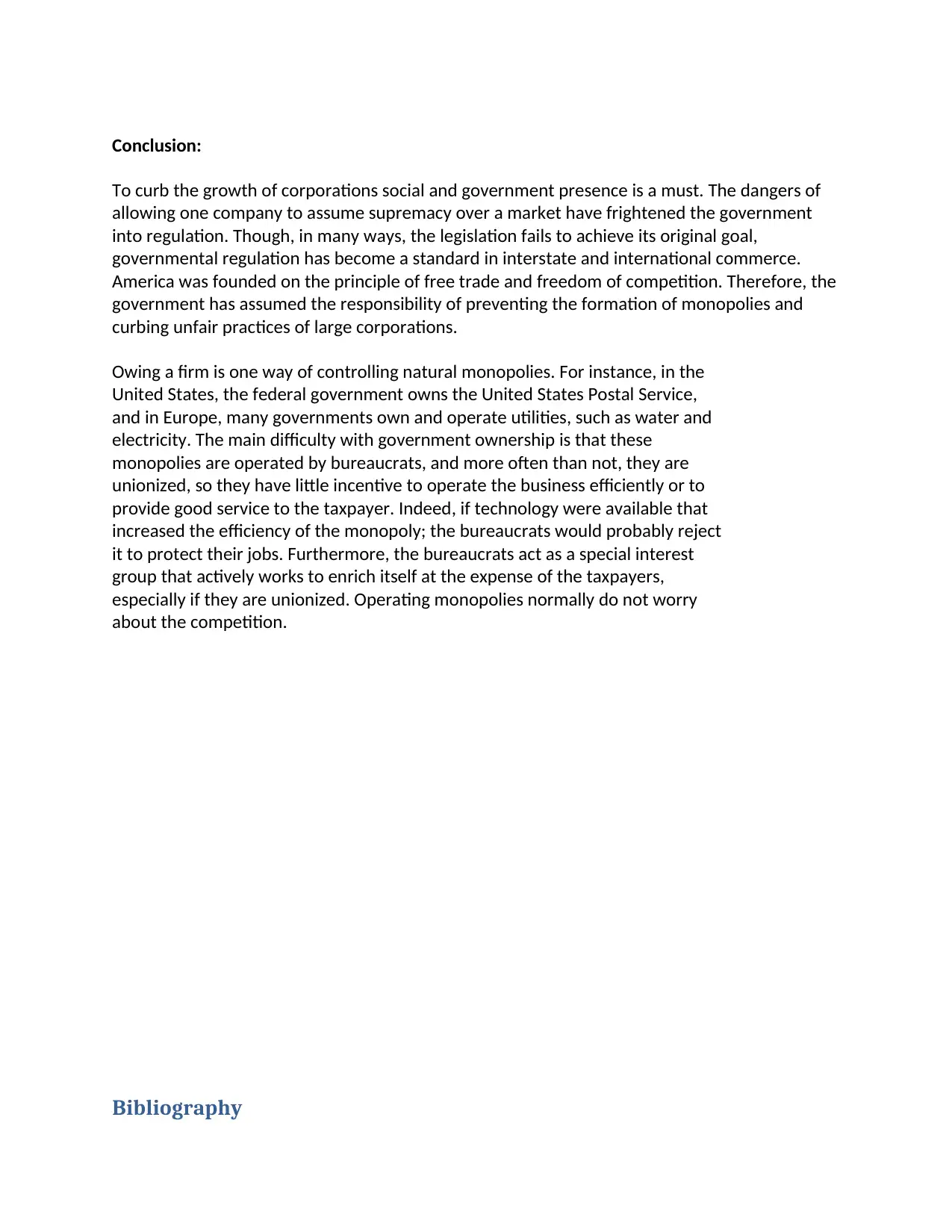
Conclusion:
To curb the growth of corporations social and government presence is a must. The dangers of
allowing one company to assume supremacy over a market have frightened the government
into regulation. Though, in many ways, the legislation fails to achieve its original goal,
governmental regulation has become a standard in interstate and international commerce.
America was founded on the principle of free trade and freedom of competition. Therefore, the
government has assumed the responsibility of preventing the formation of monopolies and
curbing unfair practices of large corporations.
Owing a firm is one way of controlling natural monopolies. For instance, in the
United States, the federal government owns the United States Postal Service,
and in Europe, many governments own and operate utilities, such as water and
electricity. The main difficulty with government ownership is that these
monopolies are operated by bureaucrats, and more often than not, they are
unionized, so they have little incentive to operate the business efficiently or to
provide good service to the taxpayer. Indeed, if technology were available that
increased the efficiency of the monopoly; the bureaucrats would probably reject
it to protect their jobs. Furthermore, the bureaucrats act as a special interest
group that actively works to enrich itself at the expense of the taxpayers,
especially if they are unionized. Operating monopolies normally do not worry
about the competition.
Bibliography
To curb the growth of corporations social and government presence is a must. The dangers of
allowing one company to assume supremacy over a market have frightened the government
into regulation. Though, in many ways, the legislation fails to achieve its original goal,
governmental regulation has become a standard in interstate and international commerce.
America was founded on the principle of free trade and freedom of competition. Therefore, the
government has assumed the responsibility of preventing the formation of monopolies and
curbing unfair practices of large corporations.
Owing a firm is one way of controlling natural monopolies. For instance, in the
United States, the federal government owns the United States Postal Service,
and in Europe, many governments own and operate utilities, such as water and
electricity. The main difficulty with government ownership is that these
monopolies are operated by bureaucrats, and more often than not, they are
unionized, so they have little incentive to operate the business efficiently or to
provide good service to the taxpayer. Indeed, if technology were available that
increased the efficiency of the monopoly; the bureaucrats would probably reject
it to protect their jobs. Furthermore, the bureaucrats act as a special interest
group that actively works to enrich itself at the expense of the taxpayers,
especially if they are unionized. Operating monopolies normally do not worry
about the competition.
Bibliography
Paraphrase This Document
Need a fresh take? Get an instant paraphrase of this document with our AI Paraphraser
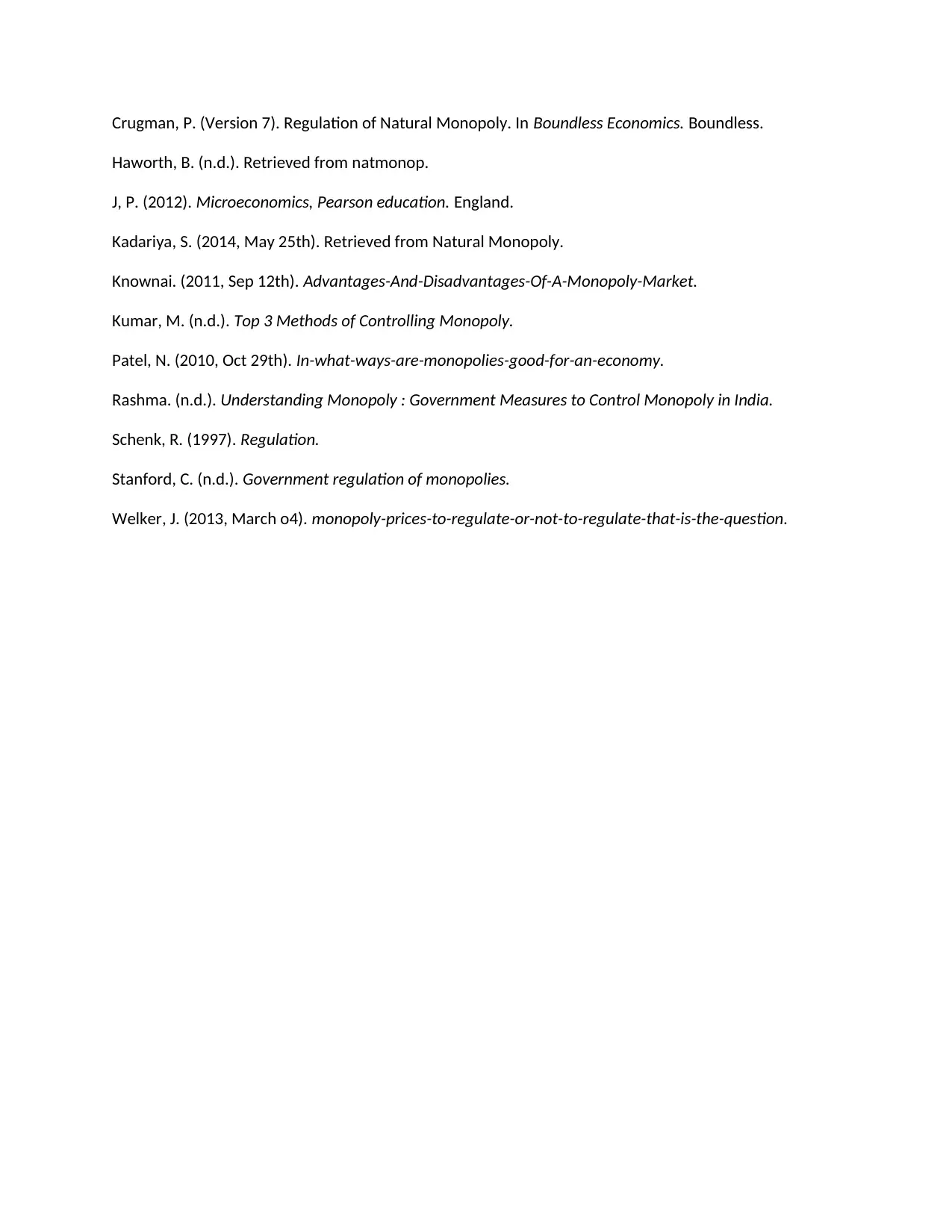
Crugman, P. (Version 7). Regulation of Natural Monopoly. In Boundless Economics. Boundless.
Haworth, B. (n.d.). Retrieved from natmonop.
J, P. (2012). Microeconomics, Pearson education. England.
Kadariya, S. (2014, May 25th). Retrieved from Natural Monopoly.
Knownai. (2011, Sep 12th). Advantages-And-Disadvantages-Of-A-Monopoly-Market.
Kumar, M. (n.d.). Top 3 Methods of Controlling Monopoly.
Patel, N. (2010, Oct 29th). In-what-ways-are-monopolies-good-for-an-economy.
Rashma. (n.d.). Understanding Monopoly : Government Measures to Control Monopoly in India.
Schenk, R. (1997). Regulation.
Stanford, C. (n.d.). Government regulation of monopolies.
Welker, J. (2013, March o4). monopoly-prices-to-regulate-or-not-to-regulate-that-is-the-question.
Haworth, B. (n.d.). Retrieved from natmonop.
J, P. (2012). Microeconomics, Pearson education. England.
Kadariya, S. (2014, May 25th). Retrieved from Natural Monopoly.
Knownai. (2011, Sep 12th). Advantages-And-Disadvantages-Of-A-Monopoly-Market.
Kumar, M. (n.d.). Top 3 Methods of Controlling Monopoly.
Patel, N. (2010, Oct 29th). In-what-ways-are-monopolies-good-for-an-economy.
Rashma. (n.d.). Understanding Monopoly : Government Measures to Control Monopoly in India.
Schenk, R. (1997). Regulation.
Stanford, C. (n.d.). Government regulation of monopolies.
Welker, J. (2013, March o4). monopoly-prices-to-regulate-or-not-to-regulate-that-is-the-question.
1 out of 8
Related Documents
Your All-in-One AI-Powered Toolkit for Academic Success.
+13062052269
info@desklib.com
Available 24*7 on WhatsApp / Email
![[object Object]](/_next/static/media/star-bottom.7253800d.svg)
Unlock your academic potential
Copyright © 2020–2025 A2Z Services. All Rights Reserved. Developed and managed by ZUCOL.




